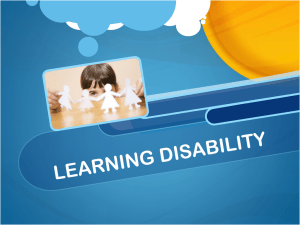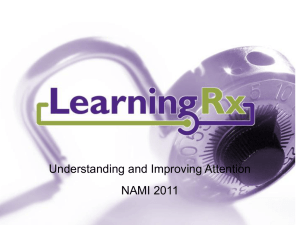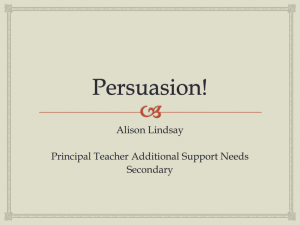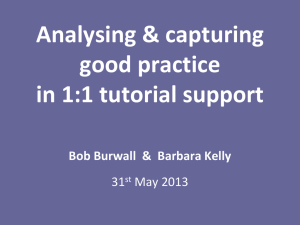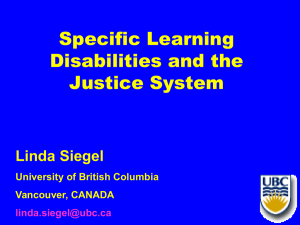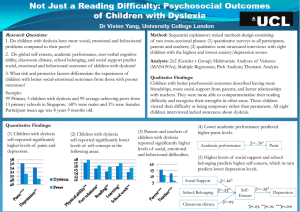Journey to Excellence Learning Together: Meeting the needs of learners
advertisement
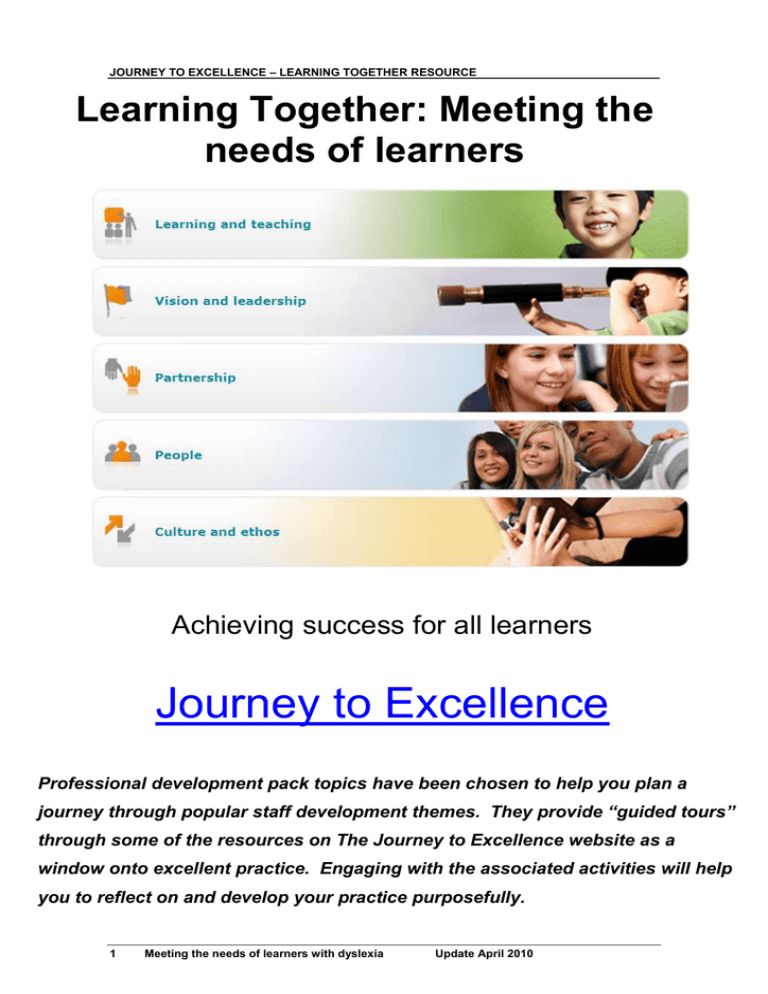
JOURNEY TO EXCELLENCE – LEARNING TOGETHER RESOURCE Learning Together: Meeting the needs of learners with dyslexia Achieving success for all learners Journey to Excellence Professional development pack topics have been chosen to help you plan a journey through popular staff development themes. They provide “guided tours” through some of the resources on The Journey to Excellence website as a window onto excellent practice. Engaging with the associated activities will help you to reflect on and develop your practice purposefully. 1 Meeting the needs of learners with dyslexia Update April 2010 JOURNEY TO EXCELLENCE – LEARNING TOGETHER RESOURCE This resource will be updated to reflect new and innovative approaches as Curriculum for Excellence is developed. Please email or comment in the box below any feedback on the resource or suggestions for improvement to help keep the resource up to date. Meeting the needs of learners with dyslexia 2 Update April 2010 JOURNEY TO EXCELLENCE – LEARNING TOGETHER RESOURCE “Children are wired for sound, but print is an optional accessory that must be painstakingly bolted on” Why children can’t read and what can we do about it? S. Pinker Purpose of this activity This pack provides opportunities for reflecting on your own practice. It explores how children learn to read and the problems encountered by children with dyslexia. It will look at how to identify children with dyslexia, and best practice in supporting their barriers to learning. The pack will draw on illustrative practice from all sectors and on the perspectives of a range of leading educationalists. The activities will enable you to: reflect on your practice against high quality practice in the area of dyslexia; extend your knowledge and expertise through studying innovative and creative practice; plan how to develop your practice to incorporate some new concepts and ideas; and share views with colleagues on identifying and supporting dyslexia. Learning outcomes Think about what you would like to achieve. What will you need to do? How will you know if you have been successful? Who is this for? This programme is for all who work with learners in all sectors. It has particular relevance for those who design and deliver learning experiences in the classroom but is also relevant to staff other than teachers. Indeed the programme has relevance for a wide range of partners and professionals working in other sectors and who contribute to developing successful learners. What will I/we need to work through this programme? You will need access to the online resource which supports The Journey to Excellence. It may also be helpful to have your copy of Education for learners with dyslexia 3 Meeting the needs of learners with dyslexia Update April 2010 JOURNEY TO EXCELLENCE – LEARNING TOGETHER RESOURCE The online resource contains three types of movies. Informative – these describe the features of each of the ten dimensions of excellence. Illustrative – these show work currently taking place in schools all over Scotland and illustrate one of the broad areas. Perspective – these are the observations made by a number of national and international education experts. Is this an individual activity or do I need to work with others? The core activities enable you to work individually at a time and place of your choice. However, there are opportunities to work with colleagues and to discuss and reflect on how learners may be motivated. You will also be asked to consider how engagement with this programme has changed and improved your classroom practice and it may be helpful to work reciprocally with a colleague to observe practice and offer mutually helpful feedback and advice. The programme of study may easily be adapted at stage, department or whole school levels to allow larger groups of staff to work through it collaboratively. How long will it take? * This pack provides materials for several study sessions, which can be followed in sequence or independently. Section Time 1 Introduction 1 hour 2 Detection and Assessment of dyslexia 45 minutes 3. Intervention - Supporting children, young people and adults with dyslexia 45 minutes 4. Working with others and transitions 45 minutes 5. Action Planning 45 minutes Meeting the needs of learners with dyslexia 4 Update April 2010 JOURNEY TO EXCELLENCE – LEARNING TOGETHER RESOURCE Introduction and Activity 1. Print the image below, or copy it onto a PowerPoint slide. You will see that the words are coloured in different colours. Working with a partner, name the colours of the words as quickly as you can. Do not read the words. For example: R RE ED D,, B BLLU UE E you would say ‘yellow’ and ‘red’ because the words are coloured in these colours. Now, take the sheet and time how long it takes to name all of the colours. If you are working with a partner get him or her to observe you and make notes about the difficulties you have. Swap over and get your partner to do the same. With your partner, think and discuss Was it easy to do the activity? Did you want to read the words rather than identify the colour of the words? How did you feel? What do you think was happening to your brain as you tried to identify the colours and not read the words? With which ones did you have most difficulty? Most people find this activity very frustrating. There is an overwhelming desire to read the words and this interferes with the naming of the colours. The brain gets confused leading to frustration and tiredness. Confusion is greatest when the colour and word are the same. It is also difficult when the colour is the same as the next word e.g. . 5 Meeting the needs of learners with dyslexia Update April 2010 JOURNEY TO EXCELLENCE – LEARNING TOGETHER RESOURCE Perhaps this is how children with dyslexia feel when they can not read simple words. In fluent readers the brain will always try to retrieve the word because it has learned to do this automatically and with great ease and fluency. In the activity you have just done, this learned behaviour impairs our ability to just name the colours. For those who are not fluent readers the confusion is not as great. So, young readers such as those in their pre-school years, will not have the same frustration and confusion. Their brain has not been trained to read words automatically. Another example of how good our brain is at retrieving sounds patterns to make words is shown below. Look at these words quickly: Dfdl Cth Nnsns What do they say? With only very limited information the brain of a fluent reader is able to fill in the gaps, predict which letter combinations go together and select the whole word with great ease. The last one is more difficult because it does not have a regular phonic pattern. There is insufficient information for the brain to retrieve the word from its sound store. For those with difficulties in processing sounds, these tasks are not quick and easy. They have to be learned over and over again. Look at these two words Train Hippopotamus If you show these words to children aged three years or under, which one do you think they identify as the word ‘Train’? The majority will pick the word ‘Hippopotamus’ because it is a long word and a train is a long object. Young children rely on the object and shape to identify the word. This is why it is important when beginning reading to match an object, or a picture of an object to the written word. As Pinker indicated in the introduction to this pack, the human brain is not pre-wired to learn how to read, but it is pre-wired to learn language. This is a good example of this innate skill. Meeting the needs of learners with dyslexia 6 Update April 2010 JOURNEY TO EXCELLENCE – LEARNING TOGETHER RESOURCE We are also pre-wired to recognise sounds in language. Children who are good at this are more likely to develop the ability to match what we say to printed letters and words on a page. Ability to repeat rhymes, sounds and patterns of sounds are very good predictors of how well we will learn to read. Look at the book in Appendix 1. On your own, with a partner or in a small group, try to answer the following questions. What is the story about? How do you know? Can you find the word which says ‘kitten’? How did you find the word? What did you look for? Now see if you can work out what any other words say. Most people look at the pictures to see what the story is about. The book is about a new kitten and the same shape is repeated on every page, except the last one. We learn to identify words by their shape and attach a sound to the shape. In this case we attach the sound ‘kitten’ to the shape )(v//0\. The next stage is to break the whole word into smaller sounds called phonics. In the story, when we have identified the word ‘kitten’, we can use our knowledge of sounds and language to work out what some of the other words say. For example, if this says )(v//o\ (kitten) then we can work out the sentence ‘/ho )(v//o\ v[ <o[[l’ by using sounds and our knowledge of grammar. We also know that nursery stories usually end with the words ‘The end’ and so we can predict what is said at the end of the story. Our knowledge of story structure helps us to work out what more words say. In this activity, it also gives us more letter sounds to work out other words. Now tackle the picture of the boy stroking the cat. Did you find this difficult to work out? Most people have problems with this page because the picture does not help. The reader has to rely on phonics and language structure to read the words. 7 Meeting the needs of learners with dyslexia Update April 2010 JOURNEY TO EXCELLENCE – LEARNING TOGETHER RESOURCE From the workshops and your own knowledge and experience, write down what you have learned about how children learn to read? Now imagine the child with dyslexia who has difficulties working out what sounds say. What difficulties will they encounter? What would they find easy and therefore, what would be their strengths in learning to read? How might this affect the way you teach reading? Meeting the needs of learners with dyslexia 8 Update April 2010 JOURNEY TO EXCELLENCE – LEARNING TOGETHER RESOURCE Activity 2: Detection and Assessment of Dyslexia Education for Learners with Dyslexia Chapter 2, pages 3 and 4 Chapter 3 As you read, highlight any ideas where you are not confident that your practice is as good as it can be. “A few authorities treated early intervention as a front-line educational strategy in addressing dyslexia.” Look at the following video clip below: Better futures for dyslexia Highlights schools, colleges and education centres with innovative methods to assist pupils with dyslexia. Staff, parents, students and pupils describe what dyslexia means to them, how it affects learning and the strategies in place to support children with dyslexia in education. As you watch the video clip make notes on: The barriers to learning to read, and therefore the difficulties encountered by learners with dyslexia What you do currently to detect learners who are at risk through failing to learn to read fluently. For example, what assessment tools and strategies do you use? Most educational authorities use a staged approach to assessment. For school-aged children and young people this usually involves: 9 the class teacher at Stage 1; more specialist input from, for example a learning support or dyslexia teacher at Stage 2; and other more expert services such as a speech and language therapist, educational psychologist or occupational therapist at Stage 3. Meeting the needs of learners with dyslexia Update April 2010 JOURNEY TO EXCELLENCE – LEARNING TOGETHER RESOURCE Detecting Dyslexia Fill out the table below or draw a mind-map in relation to children, young people and adults with dyslexia. The table asks you to note what you do well in detecting literacy difficulties in your class, in your educational establishment and as an authority/college community. It also asks you to write down what you would like to do better, and what you would need to do to make this happen. IN CLASS IN OUR ESTABLISHMENT IN LOCAL AUTHORITY/ LEARNING COMMUNITY What we do well What we need to do better How we are going to improve “I was, on the whole, considerably discouraged by my school days. It was not pleasant to feel oneself so completely outclassed and left behind at the beginning of the race." Winston Churchill on his dyslexia Meeting the needs of learners with dyslexia 10 Update April 2010 JOURNEY TO EXCELLENCE – LEARNING TOGETHER RESOURCE Activity 3: Supporting children, young people and adults with dyslexia View the movie: Rosepark Learning centre Discover how this school maximises the strengths and talents of young people to overcome difficulties with spelling and reading. Staff and pupils discuss the use of interactive teaching methods, physical activities, early identification of issues and raising awareness throughout the school. Now CHOOSE one of these: Andrew B Cameron nursery Lochyside R C Primary School Eastwood High School Reid Kerr College Refer back to Education for Learners with Dyslexia chapters 2 and 3. Below are some phrases from the document “Education for learners with dyslexia” about how some schools support learners with dyslexia. Highlight those which you feel you might benefit from finding out more about or implementing more effectively. Appoint one person to become an ‘expert’ on each of those highlighted. Each expert should search the internet, read publications, use the Movie Finder facility on the Journey to Excellence website to look for related expert perspective movies, and gather information from colleagues, with the aim of giving a three minute presentation to the group on key points to the next session. 11 Meeting the needs of learners with dyslexia Update April 2010 JOURNEY TO EXCELLENCE – LEARNING TOGETHER RESOURCE Multi-sensory approaches visual prompts Dyslexia self-help strategies fine motor skills and co-ordination programmes Dyslexia friendly approaches Mind mapping preferred learning styles Scaffolding writing reading recovery Support for Learning as an option in secondary synthetic phonics metacognition small group and 1:1 tuition Reciprocal teaching structured phonics programmes Differentiating resources for dyslexic learners Shared reading ICT support for dyslexia Literacy profiles/ tracking progress of learners with dyslexia paired reading Early intervention Intensive early literacy support IEPs Alternative assessment arrangements Share presentations on the above strategies. Then, in a small group, identify all of the strategies you use to support learners with dyslexia. You may want to think about this in relation to the Staged Intervention model referred to in Activity 2. What do you do, what does the whole establishment do and what does the authority/college community do? Meeting the needs of learners with dyslexia 12 Update April 2010 JOURNEY TO EXCELLENCE – LEARNING TOGETHER RESOURCE IN MY CLASS IN OUR SCHOOL IN OUR LOCAL AUTHORITY Strategies currently in use I’d like to know more about Now: Interview your support for learning teacher or someone who helps to support learners with dyslexia. or Interview an adult with dyslexia. Plan your interview questions to ensure that you cover strategies which you might use to help learners. Are there strategies which you have seen on the videos, or read about in the documentation which you would like to learn more about? Are there things which you are currently doing which might help you? Are their other professionals who can help to support you in supporting learners with dyslexia? Are you familiar with all of the ICT support which is now available? 13 Meeting the needs of learners with dyslexia Update April 2010 JOURNEY TO EXCELLENCE – LEARNING TOGETHER RESOURCE Activity 4: Working with others: Partnerships and Transitions The video clips in Activity 3 show that best practice involves working with others and ensuring that children, young people and adults with dyslexia make a smooth transition between and within establishments. Look at the video clips again and try to identify what works well in relation to transition and how parents, learners, teachers and other agencies work together to share information and expertise. Education for Learners with Dyslexia Chapter 4 - Partnerships Carousel Activity: Choose questions from the table below depending on the number of groups you want to form. Write each at the top of a flip chart page divided in two vertically. Put each flip chart page on a separate desk/table. Provide each group with a different coloured pen which they should keep with them on their journey. Groups should spend 5 minutes (no longer) at each flip chart in turn, writing down their ideas and leaving space for subsequent groups’ ideas to build on these. Every five minutes move all groups round until everyone has visited each station. The questions can be edited to reduce or increase the number of groups. If you are working through this pack as an individual, use the carousel questions as a questionnaire for your colleagues. As a whole group, choose three key ideas for your improvement plan in the last section. Meeting the needs of learners with dyslexia 14 Update April 2010 JOURNEY TO EXCELLENCE – LEARNING TOGETHER RESOURCE Thinking about your own establishment: What are our working relationships with a range of partners which meet the learning needs of children with dyslexia? How do health professionals provide support in assessment for example, of children’s hearing, vision, motor skills, speech and language development? How do we arrange for the educational psychologist to consult and advise teachers on strategies and further assessment to be undertaken? What do parents know about their children’s difficulties? How do they help at home? How could these be further developed? How could this be enhanced? How could this be made more effective? How could they contribute more fully to plans, reviews and meetings? Who advises us on appropriate ICT from the wide range available to support learners? Where can we get up-to-date information on ICT resources? What information do we pass on at transitions between establishments and stages? How might the information we provide and receive be improved? How do we know what children and young people feel about their experiences as they move through their education? How do we know? 15 Meeting the needs of learners with dyslexia Update April 2010 JOURNEY TO EXCELLENCE – LEARNING TOGETHER RESOURCE Activity 5: Action Planning The learning outcomes you aspire to will have been specific to your own current practice. Using your tables, mind maps and flip-charts, choose three actions from each of activities 2, 3 and 4. Write them succinctly on cards and put them in a logical sequence. Now, plan how you are going to take these actions forward within the context of your own school. Enter your chosen actions on your school’s usual planning pro forma and provide detailed information such as “who”, “by when”, “resources”, “partners” etc as appropriate. You could use turn this plan into a storyboard to film an account of the improvements you are making so that you can share your practice with others. Meeting the needs of learners with dyslexia 16 Update April 2010 JOURNEY TO EXCELLENCE – LEARNING TOGETHER RESOURCE Appendix 1 17 Meeting the needs of learners with dyslexia Update April 2010

